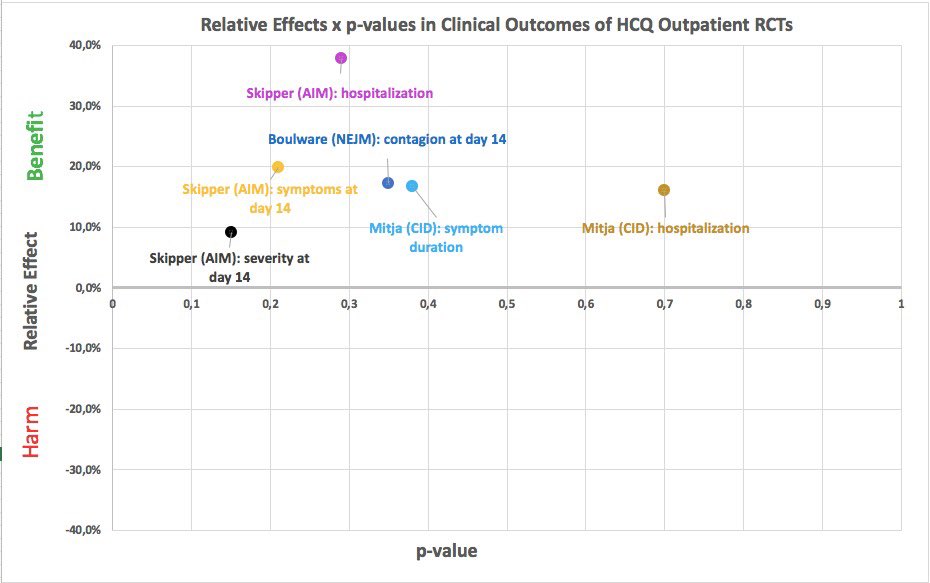1/ Here are the relative effects (Y axis) and the p-values (X axis) found for all the 6 clinical outcomes measured by the 3 outpatient RCTs of HCQ for covid (Boulware, Skipper, Mitjà).
Positive Y is benefit, negative Y is harm
See a pattern?
Positive Y is benefit, negative Y is harm
See a pattern?
2/ To spell it out: the treatment groups did better than the control groups, with p-values > 0,05, in all 6 clinical outcomes -- hospitalization, duration and severity of symptoms -- in the 3 published RCTs of HCQ for outpatients (Boulware NEJM, Skipper AIM, Mitjà CID)
3/ This suggests that these RCTs are measuring real effects but are underpowered. Very unlikely to be a due to coincidence, especially after one digs into the details of the data.
4/ Group sizes range from about 150 (in Mitjà) to about 400 (in Boulware)
This is underpowered for relative effects of ~20% in bad outcomes that are rare in baseline, especially for the young (~40yrs old median) cohorts in these RCTs
This is underpowered for relative effects of ~20% in bad outcomes that are rare in baseline, especially for the young (~40yrs old median) cohorts in these RCTs
5/ Youth dilutes the effect, if real (as most likely it is).
So does treatment delay:
* randomization 1 to 4 days after symptom onset in Boulware+Skipper, plus shipping delay
* treatment (or randomization?) median of 4 days after symptom onset in Mitjà
So does treatment delay:
* randomization 1 to 4 days after symptom onset in Boulware+Skipper, plus shipping delay
* treatment (or randomization?) median of 4 days after symptom onset in Mitjà
6/ The three RCTs are HCQ-only and suggest relative effects of ~20%. Probably larger if taken say on day 2 or 3 after treatment onset.
(Various groups have been looking into this, including from "prestigious" international universities -- prestige shouldn& #39;t matter, but does.)
(Various groups have been looking into this, including from "prestigious" international universities -- prestige shouldn& #39;t matter, but does.)
7/ In practice, early outpatients have mostly used the HCQ+azithromycin combination
The observational studies suggest that the effect of HCQ+azithromycin is larger than that of HCQ alone -- but still not a miracle cure. Maybe ~50% reduction on hospitalization.
The observational studies suggest that the effect of HCQ+azithromycin is larger than that of HCQ alone -- but still not a miracle cure. Maybe ~50% reduction on hospitalization.
8/ No antiviral effect in Mitjà (and some others). So that may not be the underlying mechanism.
But the empirical evidence on clinical outcomes says the effect (almost certainly) is real. Action is immunomodulatory? Other(s)? Time to dig deeper, not fight the data.
But the empirical evidence on clinical outcomes says the effect (almost certainly) is real. Action is immunomodulatory? Other(s)? Time to dig deeper, not fight the data.
9/ I& #39;d plot the incidence of Torsades de Pointes in the HCQ outpatient studies, but there is nothing to plot: there were none. Neither in the RCTs nor in the observational ones. Zero cases.
So it& #39;s safe. Which comes as a shocking revelation to 0% of the world& #39;s rheumathologists
So it& #39;s safe. Which comes as a shocking revelation to 0% of the world& #39;s rheumathologists
10/ In sum, early treatment with HCQ for outpatients:
* safe (except if patient has specific contraindication for HCQ)
* almost certainly has effect, about ~20% reduction in main bad outcomes
* effect may be stronger for early treatment with HCQ+azithromycin
* safe (except if patient has specific contraindication for HCQ)
* almost certainly has effect, about ~20% reduction in main bad outcomes
* effect may be stronger for early treatment with HCQ+azithromycin
11/ So many doctors and medical researchers incurring in the p < 0.05 "bright line" fallacy. It& #39;s depressing.
The American Statistical Association has pointed out this basic trap years ago but researchers keep falling into it:
https://www.statsmadeeasy.net/2016/08/bright-line-rules-are-simple-but-not-very-bright/">https://www.statsmadeeasy.net/2016/08/b...
The American Statistical Association has pointed out this basic trap years ago but researchers keep falling into it:
https://www.statsmadeeasy.net/2016/08/bright-line-rules-are-simple-but-not-very-bright/">https://www.statsmadeeasy.net/2016/08/b...

 Read on Twitter
Read on Twitter


